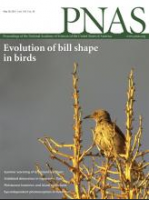“Abiotic niche lability reduces extinction risk by allowing species to adapt to changing environmental conditions in situ. In contrast, species with static niches must keep pace with the velocity of climate change as they track suitable habitat. The rate and frequency of niche lability have been studied on human timescales (months to decades) and geological timescales (millions of years), but lability on intermediate timescales (millennia) remains largely uninvestigated. Here, we quantified abiotic niche lability at 8-ka resolution across the last 700 ka of glacial-interglacial climate fluctuations, using the exceptionally well-known fossil record of planktonic foraminifera coupled with Atmosphere-Ocean Global Climate Model reconstructions of paleoclimate. We tracked foraminiferal niches through time along the univariate axis of mean annual temperature, measured both at the sea surface and at species’ depth habitats. Species’ temperature preferences were uncoupled from the global temperature regime, undermining a hypothesis of local adaptation to changing environmental conditions. Furthermore, intraspecific niches were equally similar through time, regardless of climate change magnitude on short timescales (8 ka) and across contrasts of glacial and interglacial extremes. Evolutionary trait models fitted to time series of occupied temperature values supported widespread niche stasis above randomly wandering or directional change. Ecotype explained little variation in species-level differences in niche lability after accounting for evolutionary relatedness. Together, these results suggest that warming and ocean acidification over the next hundreds to thousands of years could redistribute and reduce populations of foraminifera and other calcifying plankton, which are primary components of marine food webs and biogeochemical cycles.” >>article link

